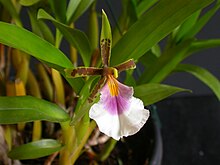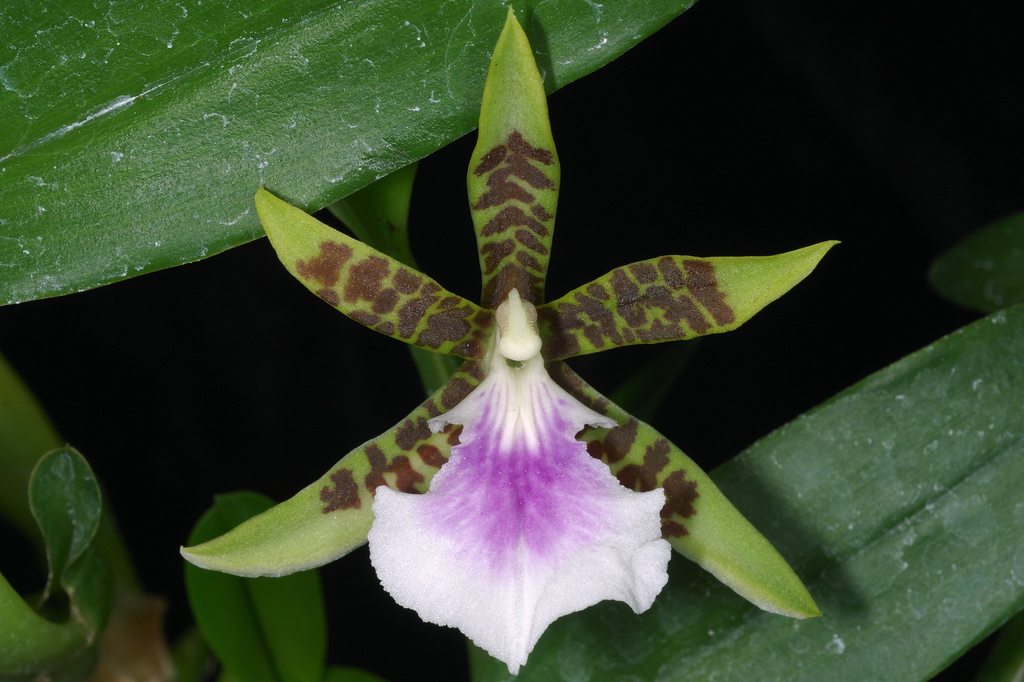Aspasia (orchid)
Aspasia variegata - Blossom
The genus Aspasia from the orchid family (Orchidaceae) comprises eight plant species that are native to Central America and South America from Guatemala to Brazil. The small, perennial plants grow as epiphytes.
Description
All species of this genus form of a creeping rhizome at a short distance pseudobulbs. These are elongate oval, laterally strongly compressed with a ridge on each side, short-stalked at the base. The pseudobulbs are surrounded by foliage leaf -like leaves down at the top of the pseudobulbs ever sit one or two leaves. The leaves are smooth and folded in the bud along the center. The leaf form is lanceolate, narrow at the base tapering.
The wenigblütige, racemose inflorescence appears laterally from the base of the pseudobulbs and does not extend beyond the leaves. The resupinierten flowers have similarly shaped, narrow sepals and petals, which may be free or fused together at the base. The petals are slightly smaller than the sepals. The lip is fused indistinctly three-lobed, and with the lower half of the column, the free part bends then perpendicular to the column from. The column itself is straight, the stamen is at its end and contains two pollinia. These are connected via a pedicel with a roundish holdfast ( Viscidium ).
Dissemination
The species of the genus Aspasia have seen a proliferation of Guatemala on the north of South America to Brazil, Colombia and Ecuador. They grow there as epiphytes in humid rain forests of the lowlands.
System
Within the subfamily Epidendroideae the genus Aspasia in the tribe Maxillarieae and there the subtribe Oncidiinae is classified.
The following eight species have been described in this genus:
- Aspasia epidendroides Lindl. (1834 ) Central America to Colombia.
- Aspasia lunata Lindl. (1836 ) Brazil.
- Aspasia lyrata ( Vell. ) Rchb.f. ( 1852), Brazil.
- Aspasia omissa Christenson (2004) Colombia.
- Aspasia principissa Rchb.f. (1852 ) Central America to Colombia and Brazil.
- Aspasia psittacina ( Rchb.f. ) Rchb.f. (1878 ) Ecuador.
- Aspasia silvana F.Barros (1989 ) Brazil.
- Aspasia variegata Lindl. (1836 ) Northern South America to Brazil.
Culture
Occasionally, these species are found in culture, such as Aspasia lunata. They require relatively high temperatures with even moisture.
Documents
- C. H. Dodson, C. A. Luer (2005): Orchidaceae part 2 (Aa - Cyrtidiorchis ). In: G. Harling, L. Andersson ( eds.): Flora of Ecuador. Vol 76, pp. 47 et seq. Botanical Institute, Göteborg University, ISBN 91-88896 -51- X
- Jürgen Röth (1983 ): orchids. Pp. 129ff. VEB German Agriculture Verlag Berlin.









